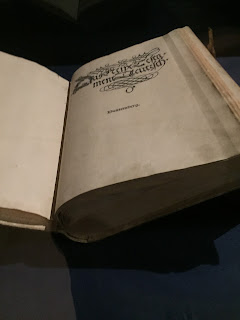In Eisenach, we once again find the intersection of Bach and Luther. Their paths crossed, albeit 200 years apart, in Leipzig, then Erfurt, and now Eisenach. As our guide pointed out: Eisanach and Bach, the two names rhyme no matter how you say it.

We started with the Bachhaus. Bach was born in Eisenach and lived in this house.

He was baptized at St. George’s Church in 1685. This is the original baptismal record from the church.
This is the baptismal font where he was baptized.

This is a replica of the piano instrument he would have grown up with.

As well as the actual family Bible of the Bachs.

Bach came from an extremely musical family, so you could say music was in his blood. In fact, if you look at St. George’s list of organists, you will see 4 Bach family members listed from 1665-1797. What a legacy!

The museum had great pods to sit in and listen to his music.

And what do you know, they have a special Reformation exhibit about Bach and Luther. Bach set many of Luther’s text to music.

We even had a special 25 minute samplings of 5 piano-like instruments that were played during Bach’s time. Isn’t it interesting how all the keys are black? Anyone know why? (Hint: It has something to do with the color of gloves they wore.)


OK, back to Luther. So Luther was sent from Mansfeld City to Eisenach for high school. He studied Latin here for three years until he went to Erfurt for college. During high school he sang at St. George’s Church and later came back to preach here, after being told not to preach anymore by the pope after the Diet of Worms.

Of course, like everywhere else, there’s a statue of him.

But the main highlight of the day was Wartburg Castle.
Luther lived here for 10 months after he was declared an outlaw at the Diet of Worms. He was on his way back from the Diet when he was kidnapped. Maybe in an area like this.

What he didn’t know, is that his protector, Elector Frederick the Wise had ordered the kidnapping to keep him safe. He was taken to this castle for safe keeping.

Now, when I think of castles, I think of cold, dark, and dreary. What a surprise to see a room like this.

In fact, it was a beautiful castle with several rooms and terrific views.

The best part was at the end. This is the very room that Luther spent most of his ten months. At his friend’s, Melanchthon’s, suggestion, Luther translated the entire New Testament in under eleven weeks! The desk and chair are not authentic but that white thing on the ground is!

It’s a vertebrae of a whale and Luther would use it as a footstool while he was writing and translating. The Bible is said to be his actual Bible with handwritten marginal notation.

The painting is an original Cranach. Interesting story about this painting: Cranach was Luther’s dear friend from Wittenberg. Nobody knew where Luther was during these 10 months of hiding in order to protect him and them. He even took on a new name: Junker Jorge (Knight George). Now you see the connection between Luther’s alias and the church in Eisenach. Anyway, Cranach was asked to paint Junker Jorge so he went to the castle. As the story goes, he painted Luther and had no idea it was him! Luther looked so different. Here are three Luthers: Monk Luther, Scholar Luther, and Knight George Luther.
Luther’s greatest achievement was his translation of the New Testament from Erasmus’ Greek and Latin texts into German. But not just any German. He translated it into a language that became the basis for the German language today. Back then, many different regions spoke different dialects. In his translation, he unified the language and in fact, many phrases are used today that he coined, nicknamed Lutheran German. After it was edited by Melanchthon, the first 3000 books printed in September 1522, sold out quickly.

Luther did some more edits and a December edition came out a few months later. Talk about a best seller!

What happened that caused Luther to leave? He was still an outlaw which meant anyone could kill him with no fear of being punished. Luther heard that riots and iconoclasm was taking place in Wittenberg. The people started smashing church statues, stained glass, paintings and altars. Luther had to put a stop to it. The Reformation was getting out of the control. So against the wishes of his friends, he returned to Wittenberg to try to get the riots to stop. But I have to stay, if I had to be in exile for 10 months, Wartburg Castle isn’t a bad place to be!




No comments:
Post a Comment